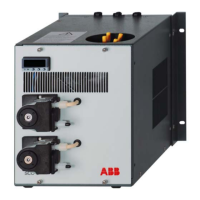
Do you have a question about the ABB SCC-C and is the answer not in the manual?
| Brand | ABB |
|---|---|
| Model | SCC-C |
| Category | Accessories |
| Language | English |
Manual covers installation, start-up, operation, and maintenance of the SCC-C Sample Gas Cooler.
Information on additional documents and internet resources for ABB products.
Explains symbols used for safety, operation, and reference numbers in the manual.
Requirements for safe operation, qualified personnel, and general safety precautions.
National regulations and contact for additional information from ABB Service.
Covers protective lead, voltage, opening covers, working with open instruments, fuses, and capacitors.
Conditions under which safe operation is no longer assured.
Cooler function, area restrictions, and site requirements like gas paths and air circulation.
Protection against adverse environmental factors and specified climatic conditions.
Details input voltage, power consumption, and starting current for the sample gas cooler.
Specifies parameters for sample gas pressure, flow, temperature, and dew point.
Lists the items included in the sample gas cooler package.
Provides a diagram with overall dimensions and component labels.
Specifies additional space needed for cooling air, pipes, and electrical lines.
Warnings regarding transport, storage, and initial setup before commissioning.
Instructions for wall mounting, cabinet installation, and releasing transport restraints.
Table specifying gas and condensate connections for different heat exchanger materials.
Alerts users to acidic condensate and necessary disposal precautions.
Explains the optional peristaltic hose pump for reagent dosing and its feed performance.
Lists the included materials for the reagent dosing unit.
Guidance on routing and connecting signal lines separately from power supply lines.
How to connect the cooler to the SCC-F sample gas feed unit for power and alarms.
Steps for connecting power, ensuring voltage, and activating the supply.
Explains the lead time period, status signals, and readiness for sample gas supply.
Emphasizes need for qualified personnel due to potential live parts.
Procedures for cleaning, removing, and installing heat exchangers, including condensate warnings.
Steps for installing the heat exchanger, connecting pipes, and ensuring sensor placement.
Steps to restart the sample gas cooler and resume sample gas flow after maintenance.
Recommends replacing hoses every 5 months and warns about condensate.
Step-by-step guide to remove old hoses and fit new ones.
Illustrates the peristaltic pump, hose, and roller mounting for reference.
Identifies when to replace pressure rollers (damaged surface) and springs (broken).
Step-by-step guide to replace pressure rollers and springs in the peristaltic pump.
Diagram showing the peristaltic pump, roller support, and related parts for replacement.
Explains why condenser fins need cleaning and the procedure using compressed air.
Detailed steps for cleaning the condenser fins.
Addresses condensate in outlet, blocked flow, and inaccurate temperature indication with causes and remedies.
Covers defective cooler issues like power supply or motor faults and troubleshooting steps.
Step-by-step guide for safely shutting down the sample gas cooler.
Information for returning the unit for repair and preparing for shipping.
Steps to activate compressor restraints and pack the unit, including overseas shipping.
Specifies ambient temperature limits for storage and transportation.
Explains the SCC-C's function within analysis systems and its cooling capabilities.
Details how the SCC-C integrates with the SCC-F feed unit and its functions.
Information on hazardous areas and suitability for flammable gases.
Explains the cooling principle and how sample gas is cooled to +3 °C.
Details the components and process of the refrigerant circuit, referencing Fig. 8.
Explains condensate removal, temperature measurement, display, and monitoring.
Instructions on how to adjust the sample gas outlet temperature set point.
Presents the electrical circuit diagram for the sample gas cooler.
Table listing critical operating parameters like temperature, dew point stability, and cooling performance.
Provides an alphabetical listing of topics and their corresponding page numbers for quick reference.